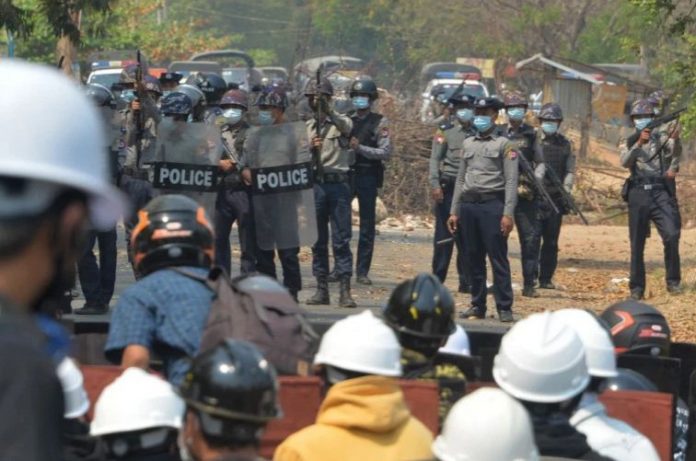The Myanmar military is using lethal tactics and an arsenal of battlefield weapons to carry out a “killing spree” against peaceful protesters who oppose the February 1 coup, Amnesty International said on Thursday after analysing video and photographic evidence from the past few weeks of mass protests.
The cache of 55 video clips offer visual proof of the “systematic and premeditated killings”, Amnesty said in a report on Thursday, as it called on the UN Security Council and the international community to take action to halt the violence.
“These Myanmar military tactics are far from new but their killing sprees have never before been live-streamed for the world to see,” said Joanne Mariner, the director of Crisis Response at Amnesty International.
Amnesty’s Crisis Evidence Lab verified the more than 50 videos of the ongoing crackdown and confirmed that security forces “appear to be implementing planned, systematic strategies including the ramped-up use of lethal force”.
“Many of the killings documented amount to extrajudicial executions,” the rights group said.
The footage clearly shows that Myanmar military troops, also known as the Tatmadaw, “are increasingly armed with weapons that are only appropriate for the battlefield, not for policing actions”, the report added.
Officers were captured on video frequently seen engaging in “reckless behaviour”, including the indiscriminate use of live ammunition in built-up areas.
The latest findings bolster a February report from Amnesty that concluded security forces deployed machine guns against peaceful protesters and shot one woman in the head during a anti-military government demonstration.
On Wednesday, police officers who fled to India, told the Reuters news agency that they were instructed by the military to single out demonstrators and to “shoot ’till they are dead”.
‘Murderous methods’
Myanmar plunged into a political crisis on February 1 after the military arrested the country’s elected leaders including Aung San Suu Kyi and seized power in a coup, claiming without evidence that last November’s election was fraudulent.
In the weeks since, there have been almost daily protests against the coup and a mass civil disobedience campaign under which doctors, teachers, factory workers and others have gone on strike. The military has responded with increasing force and the United Nations said last week that at least 50 people had been killed.
“These are not the actions of overwhelmed, individual officers making poor decisions. These are unrepentant commanders already implicated in crimes against humanity, deploying their troops and murderous methods in the open,” the Amnesty report said.
“The military authorities must immediately cease their deadly onslaught, de-escalate the situation nationwide, and release all those arbitrarily detained.”

The video clips, dating between February 28 and March 8, were recorded by members of the public and local media in cities including Dawei, Mandalay, Mawlamyine, Monywa, Myeik, Myitkyina and Yangon.
In one video taken in Sanchaung township in Yangon on March 2, a commander can be seen standing over a sniper. The commander appears to be giving him orders to fire directly at specific protesters.
In another clip dated March 3 in North Okkalapa township, also in Yangon, officers are seen leading a man towards a larger group of security forces.
The man appears to be in the group’s custody and offers no visible resistance, when an officer beside him suddenly shoots him. The man immediately drops to the ground and is left on the road, apparently lifeless, for several seconds before officers walk back and drag him away.

Police beat a protester as they detain him during a demonstration against the military coup in Yangon on Saturday [Stringer/AFP]
In another verified clip dated February 28, a member of the military in Dawei is seen apparently lending his rifle to a police officer deployed alongside him. The officer crouches, takes aim and shoots, before a group of officers standing with them celebrate.
“Not only does this incident show a reckless disregard for human life, making sport of shooting live rounds at protesters, it also reveals deliberate coordination among security forces,” said Amnesty’s Mariner.
Machine guns and Uzis
Amnesty also identified security forces armed with a variety of military firearms, including China-made RPD light machine guns, as well as local MA-S sniper rifles, MA-1 semi-automatic rifles, Uzi-replica BA-93 and BA-94 submachine guns and other arms manufactured in Myanmar.
“These weapons are completely inappropriate for use in policing protests,” Amnesty said, citing UN guidelines, which state that security forces should refrain from the use of firearms unless there is an imminent threat of death or serious injury.
“The weaponry deployed by the Tatmadaw reveals a deliberate and dangerous escalation in tactics,” Mariner noted.
“Not content with indiscriminately using less-lethal weapons, each new day shows an apparent order to deploy semi-automatic rifles, sniper rifles and light machine guns in increasing numbers. Make no mistake, we are in a deadly new phase of the crisis.”
Amnesty also revealed that further analysis of photos and video showed that the generals had deployed the Yangon Command, Northwestern Command, and the 33rd, 77th and 101st Light Infantry Divisions (LID) of the military to be part of the crackdown “and sometimes lending their weapons to police officers”.
The soldiers were deployed in Yangon, Mandalay and Monywa, which have seen “extreme instances of excessive force”, including killings, by security forces in recent days.
Some of the military divisions have been accused of committing similar atrocities and “serious human rights violations” in Rakhine, Kachin, and northern Shan States.
Other military units were also implicated in “crimes against humanity” against the Muslim Rohingya in Rakhine State in 2017.
“As the death toll surges, the UN Security Council and the international community must move beyond words of concern and immediately act to halt violations and hold perpetrators accountable,” Mariner said.
Source : AL JAZEERA












